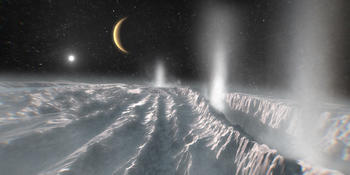Landing on Saturn's moon Enceladus and search for extraterrestrial life top target for new ESA mission
News from Apr 15, 2024
The European Space Agency ESA is following the recommendation of a team of experts with the significant participation of Prof. Dr. Frank Postberg, head of the Planetary Sciences and Remote Sensing working group at Freie Universität Berlin, for ESA's next major planetary missions. The plan is to land a probe on Enceladus to search for life in the subcrustal ocean!
After Juice, LISA and NewAthena, the mission would be the first "major mission" of Voyage 2050, ESA's long-term plan for scientific activities in space. The overarching theme - "Moons of the giant planets of the solar system" - was already adopted by ESA in 2021. To translate this theme into more concrete mission concepts, ESA selected a panel of high-level planetary scientists to pool their knowledge and experience. The mission was to focus on the habitability of an ocean world, looking for signs of past or present life and trying to identify life-friendly chemistry on the surface. Enceladus fulfills all of these conditions and the mission profile now presented goes even beyond the original objective and is designed to detect extraterrestrial life if it is present on Enceladus.
The technologically ambitious and extraordinarily challenging mission is due to be launched at the beginning of the 2040s and will consist of an orbiter which, in addition to remote sensing instruments such as cameras, radar and spectometers, will also be able to examine the ice particles emitted by Enceladus in situ during the flyby. These ice particles originate from a huge ocean beneath the ice crust in which life-friendly conditions prevail as far as we know. A landing unit will then touch down in the south polar region of the moon and examine surface samples, which also consist of cryo-volcanically frozen ocean material. Prior to this, the probe will carry out a "moon tour", i.e. flybys of some of Saturn's moons. Of particular interest are, for example, Mimas, Thetys, Dione, Rhea and Titan, where oceans are also suspected under the ice shell. To complete the mission, two separate Ariane 6 (A64) launches and a rendez-vous with docking maneuver in space are necessary before the journey to the Saturnian system can begin. Due to the large distance to the Sun, the spacecraft will require the largest solar panels ever designed for such a spacecraft.
With this ambitious mission, in which ESA is searching for extraterrestrial life forms for the first time with specially designed instruments, the space agency sees itself in a leading role worldwide in answering one of the big questions facing humanity
